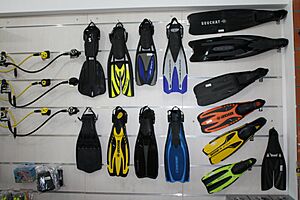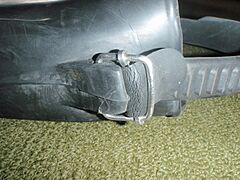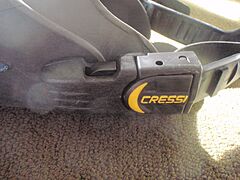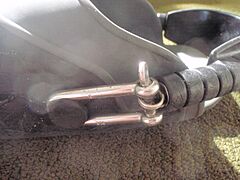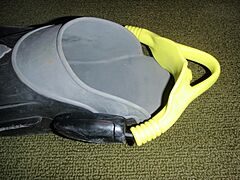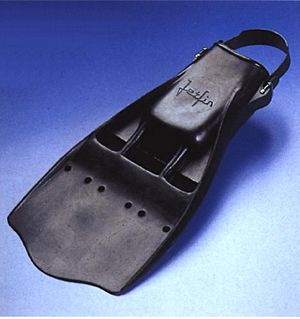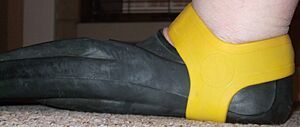Swimfin facts for kids

Full foot fins
|
|
| Other names | Fins, flippers |
|---|---|
| Uses | Diver and swimmer propulsion |
Swimfins, also called swim fins or flippers, are special gear you wear on your feet. They are shaped like fins and help you swim much faster! They are usually made from rubber, plastic, or carbon fiber.
Swimfins work by pushing more water with each kick than your bare feet can. This extra push helps you move through the water with more power and speed. Many people use swimfins for different water sports. These include swimming, scuba diving, snorkeling, spearfishing, and even underwater games like underwater hockey and underwater rugby.
Contents
Who Invented Swimfins?
People have thought about using fin-like tools to swim faster for a long time. Famous thinkers like Leonardo da Vinci and Giovanni Alfonso Borelli imagined designs similar to duck's feet. Even Benjamin Franklin made a type of swimfin for his hands when he was a young boy!
The modern swimfin we know today was invented by Louis de Corlieu. He was a French Navy officer. He first showed his invention to the Navy in 1914. Later, in 1926, he left the Navy to focus completely on making his swimfins. He finally started making them in large numbers in France in 1939.
In the same year, an American named Owen Churchill got permission from de Corlieu to make the fins in the United States. Churchill showed his fins to the U.S. Navy. "Churchill fins" were even used by soldiers during World War II. In Britain, a company called Dunlop made similar fins for special forces called frogmen during the war.
Different Kinds of Swimfins
There are many types of swimfins, each designed for different activities.
- Snorkelers often use fins that are light and flexible.
- Free divers use very long fins. These help them glide through the water with less effort, saving their energy for deep dives.
- Scuba divers usually need bigger, wider fins. This is because their heavy diving equipment creates more drag in the water.
- Players of Underwater hockey and underwater rugby need fins that give them power for swimming straight. They also need to turn quickly, so their fins help with both.
Most fins come as a pair, with one for each foot. These are called bifins. But there's also a monofin. This is one wide fin blade that connects to both of your feet. Monofins look a lot like how people imagine a mermaid's tail!
Some swimfins cover your whole foot, like a slip-on shoe. These are called full-foot, closed-heel, or slipper fins. Other fins have an open heel. They have a pocket for the front of your foot and an adjustable strap that goes behind your heel.
The flat part of the swimfin, called the paddle, can have different shapes. Some paddles have special holes called vents. These vents let water pass through when you move your leg up (the recovery stroke). But they block water when you push down (the power stroke). This design helps swimmers save energy during their kicks.
If your swimfins feel too loose, you can use a fin grip or fin retainer. These are Y-shaped rubber straps. You wear them over the middle of your foot, your heel, and the top of your foot. They help keep your swimfin securely in place.
How to Use Swimfins
When wearing swimfins, swimmers can use different kicking styles to move through the water.
- Flutter Kick: This kick uses both legs moving up and down from your hips. Your legs move opposite each other. When one leg goes up, the other goes down, like scissors.
- Frog Kick: This kick looks like a frog swimming! Both legs come up towards the center. Then, your knees turn outwards, and your heels stay close to the bottom. You slowly push your legs out and then quickly bring them together. This makes your body straight and helps you glide.
- Dolphin Kick: This kick uses both legs moving together at the same time. It's the only kick you can use with a monofin. You move your legs up and down like a dolphin's tail.
- Other kicks, like the back kick and the helicopter turn, help you move and turn in different directions underwater.
Fun Facts About Swimfins
- The first rubber fins were invented by Louis de Corlieu. They had a metal core inside to keep them stiff.
- Early "de Corlieu" swimfins were used in aquatic festivals and competitions in Paris.
- The first recorded time for someone using fins was 59 seconds to swim 216 feet (66 meters).
- The first monofin appeared during aquatic "ballets." It was made by gluing two "de Corlieu" fins together in the middle.
- In 1950, Luigi Ferraro designed a new style of swimfins. His fins covered the whole foot but left the toes free.
- Ferraro also started organizing competitions where swimmers used fins.
- Fins can be made from rubber, plastic, and carbon fiber.
- When Benjamin Franklin was 11 years old, he invented swimfins for his hands. He said they helped him swim faster but made his wrists tired!
See also



